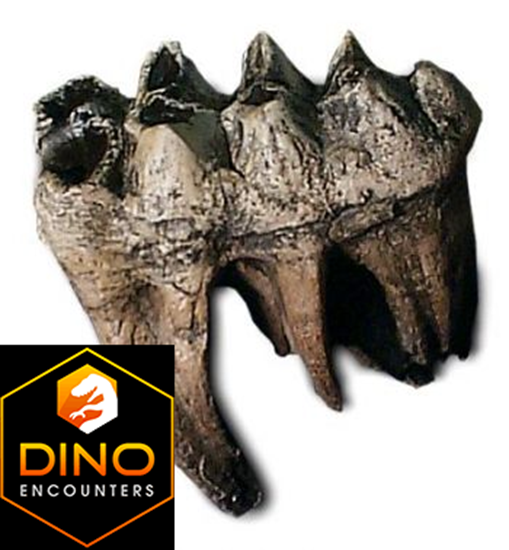Dino Encounters Store - Mammut americanium, mastodon tooth
$70.80
Description
Mastodons are any species of extinct proboscideans in the genus Mammut, distantly related to elephants that inhabited North and Central America during the late Miocene or late Pliocene up to their extinction at the end of the Pleistocene 10,000 to 11,000 years ago. Mastodons lived in herds and were predominantly forest dwelling animals that fed on a mixed diet of browsing and grazing with a seasonal preference for browsing, in contrast to living elephants that are mostly grazing animals. The American mastodon resembled a woolly mammoth in appearance, with a thick coat of shaggy hair.
Mammut americanum, the American mastodon, is the youngest and best-known species of the genus. They disappeared from North America as part of a mass extinction of most of the Pleistocene megafauna, widely presumed to have been related to overexploitation by Clovis hunters, and possibly also to climate change.
Modern reconstructions based on partial and skeletal remains reveal that mastodons were very similar in appearance to elephants and, to a lesser degree, mammoths, though not closely related to either one. Compared to mammoths, mastodons had shorter legs, a longer body and were more heavily muscled, a build similar to that of the current Asian elephants. The average body size of the species Mammut. americanum was around 2.3 m (7 ft 7 in) in height at the shoulders, corresponding to a large female or a small male, but large males could grow up to 2.8 m (9 ft 2 in) in height and weigh as much as 4.5 tones. Like modern elephants, the females were smaller than the males. They had a low and long skull with long curved tusks, with those of the males being more massive and more strongly curved. Mastodons had cusp-shaped teeth, very different from mammoth and elephant teeth (which have a series of enamel plates), well-suited for chewing leaves and branches of trees and shrubs.
Mammut americanum, the American mastodon, is the youngest and best-known species of the genus. They disappeared from North America as part of a mass extinction of most of the Pleistocene megafauna, widely presumed to have been related to overexploitation by Clovis hunters, and possibly also to climate change.
Modern reconstructions based on partial and skeletal remains reveal that mastodons were very similar in appearance to elephants and, to a lesser degree, mammoths, though not closely related to either one. Compared to mammoths, mastodons had shorter legs, a longer body and were more heavily muscled, a build similar to that of the current Asian elephants. The average body size of the species Mammut. americanum was around 2.3 m (7 ft 7 in) in height at the shoulders, corresponding to a large female or a small male, but large males could grow up to 2.8 m (9 ft 2 in) in height and weigh as much as 4.5 tones. Like modern elephants, the females were smaller than the males. They had a low and long skull with long curved tusks, with those of the males being more massive and more strongly curved. Mastodons had cusp-shaped teeth, very different from mammoth and elephant teeth (which have a series of enamel plates), well-suited for chewing leaves and branches of trees and shrubs.
